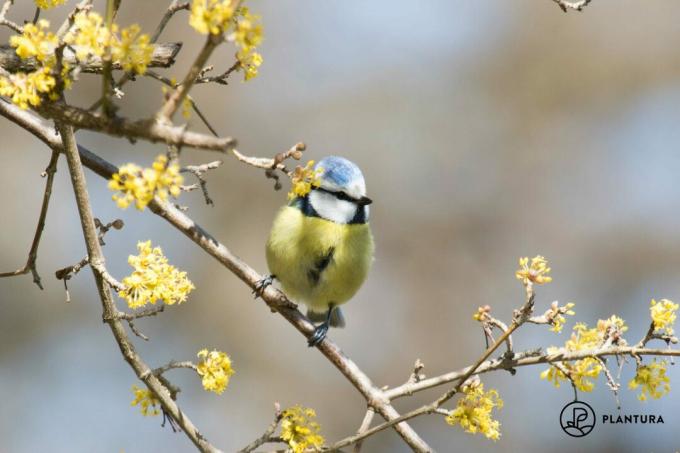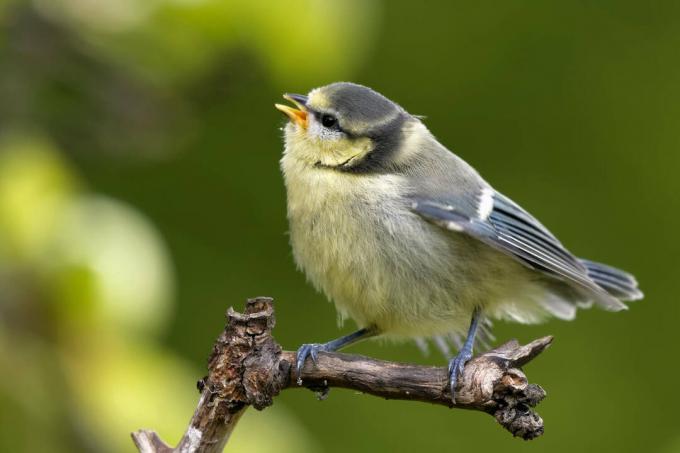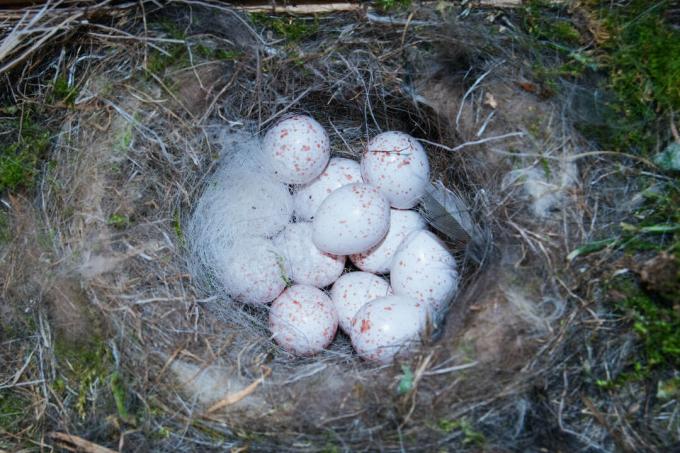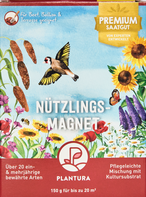What do blue tits look like, when do they breed and what do they eat? In this article we answer all questions about the native blue tit.

The blue tit (Cyanistes caeruleus) is also one of our smallest and most frequent guests in domestic gardens. At just 11 grams, it weighs less than a packet of baking powder and is anything but inconspicuous. In fact, with its colorful plumage and lively demeanor, the blue tit is one of our most eye-catching bird species. Basically, she can never sit still and even shimmy upside down on thin branches through the treetops.
contents
- Blue tits: A detailed profile
-
How to recognize the blue tit
- What does the song of the blue tit sound like?
- How do you recognize the young birds?
- How do you recognize blue tit eggs?
- How do female and male blue tits differ?
- Which habitat do blue tits prefer?
- Where do they build their nest?
- When do blue tits breed?
- Where do blue tits spend the winter?
-
Support blue tits: Here's how
- What do blue tits eat?
- Which nest boxes are suitable for blue tits?
- How can you provide additional support for blue tits?
Blue tits: A detailed profile
| size | About 12cm |
| Weight | Approximately 11g |
| breeding season | April May |
| lifespan | Up to 5 years |
| habitat | forests, parks and gardens |
| feed preference | Insects and their larvae, seeds, berries (true "omnivores") |
| threats | Decrease in natural habitat and food supply |
How to recognize the blue tit
The blue tit is easily recognized by its blue-green back and yellow underparts. A dark, vertical line runs across the chest and abdomen, the white face is crossed by a narrow, black eye stripe and the parting forms a blue "cap". One can actually only confuse the blue tit with the great tit, which differs from her little sister in that she is slightly taller and has a black head. Since young blue tits and great tits already look quite similar to their parents, these can also be distinguished early on by the characteristics mentioned.

What does the song of the blue tit sound like?
The song of the blue tit begins with two high, clear elements and ends in a trilling verse: "Tsi-tsi-tsürrrr". Overall, the bird's voice sounds very bright and lovely.
The blue tit song sounds like this:
How do you recognize the young birds?
Young blue tits are not yet colored as intensively as their parents. They are characterized by an inconspicuous blue-grey upper side and a whitish-yellow underside. The eye stripe and the skullcap, which is greyish at first, are formed early on, so you can clearly see the little ones.

How do you recognize blue tit eggs?
On average, a female lays about 7 to 13 eggs per brood, although clutches of up to 19 eggs have also been documented. The eggs are about the size of a fingernail, cream colored and mottled with red. They are laid one after the other and are only incubated when the clutch is complete.

How do female and male blue tits differ?
Unlike many other bird species, blue tits have males and females of the same colour, making it very difficult to unequivocally determine the sex of an individual. Common features are the blue crown, which is usually more intensely blue in males than in the females, and the black collar somewhat broader and darker in the males fails. However, these characteristics vary between individuals and are not always clear, especially to the untrained eye.
Which habitat do blue tits prefer?
Naturally, blue tits prefer old deciduous forests where they find plenty of food in the form of insects and spiders, as well as nesting sites. Despite the lack of this habitat today, the blue tit is considered one of the most common bird species in Germany. The small birds have proven to be extremely adaptable and today colonize man-made structures such as parks and gardens on a large scale.
Where do they build their nest?
Blue tits are cavity breeders and use natural tree cavities and crevices as breeding sites in which they build nests out of moss and small twigs and then cover them with animal hair and feathers pad. In the absence of suitable tree cavities, blue tits are very creative and find refuge in wall cracks, holey facades or even old mailboxes.

When do blue tits breed?
The breeding season of the blue tit begins in mid-April. The eggs are incubated for about two weeks, the young birds are fed in the nest for 16 to 18 days after hatching. After that, the young flee, but remain dependent on their parents for some time as so-called fledglings, which are not yet experienced enough to look after themselves. After the successful rearing of the first brood, a second one occasionally follows, which can extend the breeding period until the beginning of August.
Where do blue tits spend the winter?
The blue tit is in Germany a resident bird, that is, she spends the winter with us and does not move south. Due to the lower food supply, however, it can happen that blue tits retreat to reed areas and feed on the insect larvae that overwinter there. Smaller groups are also often formed in winter, in which the blue tits even hunt side by side with other species such as the great tit or goldcrest.
Support blue tits: Here's how
Due to the progressive loss of natural habitat, the blue tit, like many other bird species, is dependent on man-made habitats. However, important structures such as old trees with cavities and crevices in which the blue tits can build their nests are often missing there. The food supply also quickly becomes scarce, especially in winter. However, it is easy to support the small birds by offering food and artificial nesting facilities.

What do blue tits eat?
Before feeding the birds, the question arises: what do blue tits eat? The diet of the blue tit consists mainly of insects and their larvae - caterpillars make up a main part of the diet, especially when rearing the nestlings. But they also use a variety of seeds, nuts and berries and are therefore real omnivores. Who additionally purchased or homemade bird seed would like to offer should reach for sunflower seeds and broken peanuts. Fat cake or fat dumplings are also gladly accepted. Our Plantura fat balls are an ideal choice for this because they consist of natural, nutrient-rich ingredients and come without plastic nets that create waste and in which the little tits get tangled and hurt could. A special feature that all tits have in common is that they prefer hanging feeding places.

Plantura fat balls
Sustainable fat balls without a net,
Species-appropriate wild bird food with insect fat for year-round feeding
Which nest boxes are suitable for blue tits?
Since blue tits are cave breeders, any offered nesting box should be round except for one Entry hole must be closed all around (it should, however, be possible to open it for occasional cleaning be). An ordinary tit box, which is suitable for all species, has an entrance hole of 32 mm. If you want to specifically support blue tits and rule out competition with the slightly larger great tit, you should choose an entrance hole of 26 – 28 mm.
How can you provide additional support for blue tits?
If you want to provide additional support for your blue tits breeding in the nest box, you can ensure that there is an adequate natural food supply. In fact, there are often not enough caterpillars in gardens to raise the young. This can be remedied by promoting popular food plants for the caterpillars, such as nettle, blackberry, willow or sloe. Furthermore, the use of chemical pesticides should be avoided, as these have a negative impact on the supply of caterpillars and have toxic effects on the birds via the food chain be able.
In addition to additional lining, a bird bath placed in the garden, which is particularly useful in hot temperatures. This should be flat enough for the birds to stand in and – since the bowls are also often used as a bath – should be cleaned regularly.
In addition, of course, all insect-promoting measures are also good for the blue tit - such as creating a beneficial insect meadow. Our Plantura beneficial insect magnet offers a wide range of food and habitat for numerous insect species.

Plantura beneficial insect magnet
Annual & perennial species for beneficial insects
such as birds, bees & Co, easier to care for
Blossom dream in bed, pot & window box
More tips for Designing an insect friendly garden you'll find here. Of course, this also benefits other bird species, such as the great tit.
...and receive concentrated plant knowledge and inspiration directly in your e-mail inbox every Sunday!



